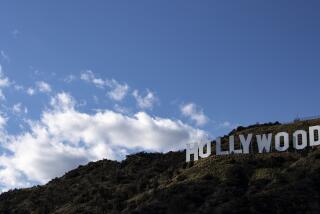WORLDLY LENS MAN : He’ll Give U.S. a Shot, but China Is His Home
- Share via
Ask for the foreigner on the set of most of the big Hong Kong productions and you’ll usually find Christopher Doyle hunched behind the lens of a camera. The Chinese film crews call the Australian-born cinematographer either mingling shiyingshi (“star camera man”), Du Ke Feng (his Chinese name, which means “Like the Wind”), “Ah Chris” or “the Chinese with the skin problem.”
“Most of the time,” Doyle says, “they just call me ‘ah gweilo’--a term of endearment that translates roughly as ‘our foreign devil friend.’ ”
He speaks a fluid Mandarin that is as ripe with slang as a Chinese sailor’s. But Doyle, 45, has a slight 5-foot-6-inch frame, shocking blue eyes, a mess of salt-and-pepper corkscrew curls and a trademark expression between a grin and a leer that makes him look like a debauched leprechaun.
Never mind his Western appearance; Doyle considers himself a Chinese filmmaker. In the last five years, in fact, Doyle has crafted some of the most visually stunning films to come out of Hong Kong and China. Critics wrote that his dazzling cinematography for “Temptress Moon,” directed by mainland Chinese master Chen Kaige, distinguished an otherwise incoherent film, and that his collaboration with Hong Kong director Wong Kar-Wai on “Days of Being Wild,” a visual feast of lush sepia-toned sequences, helped to revolutionize the way the former colony’s filmmakers considered their own craft. Since he began working on feature films in the late 1980s, Doyle has trained his camera on almost every major Chinese star, from Gong Li to Leslie Cheung to Joan Chen.
Although his speech somehow combines French and Chinese inflections--even when he’s speaking in English--Doyle was actually born in Sydney in 1952. At 19, he dropped out of college, joined the merchant marines and sailed around Europe and Asia. He then tried his hand at a series of very odd jobs, including irrigation specialist, miner and, as he describes, a “seller of quack medicines” in Thailand. He decided to learn Mandarin Chinese in Hong Kong when he realized that more than a fifth of the world spoke it. After a few years of studying, he moved to Taiwan with an experimental theater group. There, he promptly fell in love with a French-born Chinese woman and married her. (They divorced after eight years.)
In Taiwan, he was surrounded by actors, dancers and filmmakers, an environment that inspired his own awkward fumblings with the camera. He made what he calls “experimental films,” exploiting every cinematic mistake--”[lousy] filters, distorted lenses, unflattering angles, you name it,” he says--and was soon hired as a television documentarist. Then, Taiwan director Edward Yang gave him his first big break, hiring him as the camera man for his feature film, “That Day on the Beach.”
Doyle is most closely aligned with Wong Kar-Wai and art director William Chang, with whom he’s worked on five films. Their working style has become legendary in Asia. The three start with a skeletal script, establishing only the story’s period, core cast and location. Then they write and rewrite scenes daily; they shoot footage until a story emerges.
‘Ashes of Time,” the trio’s existential martial arts film, used so much celluloid that one of the disgruntled stars told the press, “They could make 12 movies if they wanted to.” It is not the usual modus operandi of Hong Kong’s fast-paced film factories.
And yet it has brought results. And glory. In 1995, Doyle was awarded the Venice Film Festival Osella d’Oro award (best cinematography). He has won several Golden Horse (Taiwan’s Oscar equivalent) and Hong Kong Film Awards honors.
Doyle’s latest collaboration with Wong and Chang is “Happy Together,” which opened Oct. 31.
“ ‘Happy Together’ was such a turning point for us,” Doyle says. “We stripped away all the physical trappings of Hong Kong. We removed narrative. Our work was no longer an exercise in style. This is our simplest film. And all three of us agree it is our best.”
It was only a matter of time before Hollywood’s powerhouse agencies came pounding on his door; Doyle has no fewer than three agents at International Creative Management. (“Seems there’s a power struggle over little ol’ me,” he says, shrugging.) In one recent 10-day period, he crossed the Pacific six times for business meetings. But Asia’s star cameraman practically snorts at the idea of leaving his home in the East to work in the West.
“Hollywood has become like the immigration department for Hong Kong Chinese,” he says poolside at the Hollywood Hills home of two of his friends, directors Philip Noyce and Jan Sharp. “Especially for a generation of Chinese filmmakers like John Woo and Ang Lee, Hollywood has been a lifelong dream. For me, it never has.”
Doyle has long been adamant that “if you go to America, you start to make films for Americans. Why should I make films for Americans? I don’t particularly desire to adapt to the worldview. I’d rather work with people who have a larger perspective on life.
“People say, ‘You’re obviously here for the money,’ ” he says. “I tell them, ‘You obviously have no idea what’s going on in Asia.’ ”
In addition to Chinese movie-makers, Doyle has been enlisted for work by Japanese and Korean directors, who have considerable economies backing their projects. “I make as much as the top guys in the U.S. People here are shocked when I tell them my salary. But there are cameramen in China making more than I do.”
And yet there is little denying that his flirtation with the American film industry has been serious and constant for the last three years. So why is he here? Doyle raises his palms in the air. “I’m just looking,” he says. “I’m not that technically confident, so I want to increase my vocabulary as a cinematographer.”
Doyle already has plans to work with Sharp on an independent English-language feature set in 1920s Shanghai and starring Hong Kong actress Michelle Yeoh. But he says he will do his work in America with the intention of “a spy.”
“I’ll take whatever knowledge I gain back with me to Hong Kong,” Doyle says. “Because Chinese filmmaking has to move forward.”
More to Read
Only good movies
Get the Indie Focus newsletter, Mark Olsen's weekly guide to the world of cinema.
You may occasionally receive promotional content from the Los Angeles Times.










